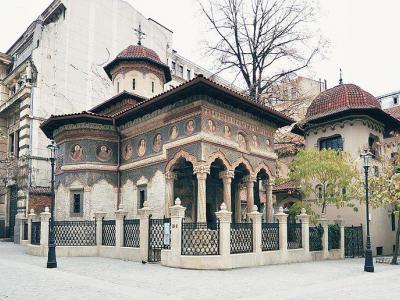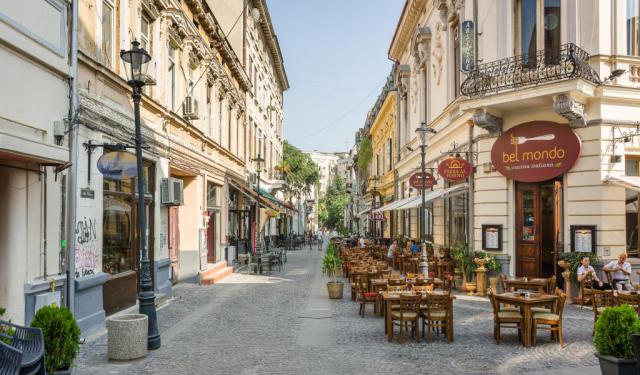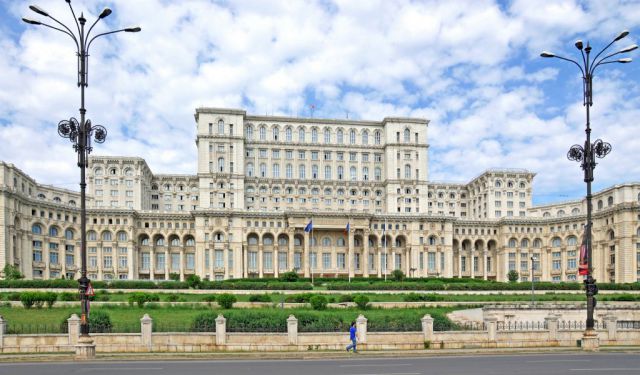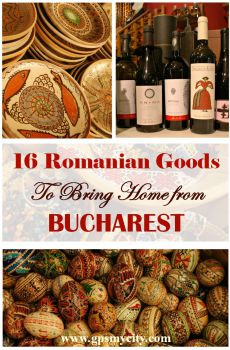
Stavropoleos Convent, Bucharest (must see)
Stavropoleos Convent, also known - during the last century when the convent was dissolved - as Stavropoleos Church, is an Eastern Orthodox nunnery in central Bucharest, Romania. Its church is built in Brâncovenesc style. The patrons of the church are Saint Archangels Michael and Gabriel. The name Stavropoleos is a Romanian rendition of a Greek word, Stauropolis, meaning "The city of the Cross". Among other things the convent is particularly famous for is Byzantine music; it has a choir and the largest collection of Byzantine music books in Romania.
The church was built in 1724, during the reign of Nicolae Mavrocordat (Prince of Wallachia, 1719-1730), by archimandrite Ioanichie Stratonikeas. Within the precinct of his inn, Ioanichie built the church and a convent which was economically sustained with incomes from the inn. In 1726 abbot Ioanichie was elected metropolitan of Stavropole and exarch [the deputy of a patriarch] of Caria. Since then the convent he built has been known as Stavropoleos, after the name of its old seat. On February 7, 1742 Ioanichie, aged 61, died and was buried in his church.
The inn and the monastery's annexes were demolished at the end of the 19th century. Over time the church suffered from earthquakes, which caused the dome to fall. The dome's paintings were restored at the beginning of the 20th century. All that remains from the original nunnery now is the church, alongside the building, dating back to the early 20th century, which shelters a library, a conference room and a collection of old (early 18th century) icons and ecclesiastical objects, as well as parts of the wall paintings recovered from churches demolished during the communist regime. This new building was constructed to a plan by architect Ion Mincu.
The convent's library contains over 8,000 books on theology, Byzantine music, arts and history. There are patristic, biblical, dogmatic, liturgic, historical, homiletic, catechetic writings, as well as classic languages dictionaries and textbooks, studies on Byzantine art and Orthodox iconography, plus those on the Romanian history and civilization of the 18th century. Some of the books have been donated from the personal library of art historian Vasile Drăguţ, former rector of the Bucharest University of Arts.
The church was built in 1724, during the reign of Nicolae Mavrocordat (Prince of Wallachia, 1719-1730), by archimandrite Ioanichie Stratonikeas. Within the precinct of his inn, Ioanichie built the church and a convent which was economically sustained with incomes from the inn. In 1726 abbot Ioanichie was elected metropolitan of Stavropole and exarch [the deputy of a patriarch] of Caria. Since then the convent he built has been known as Stavropoleos, after the name of its old seat. On February 7, 1742 Ioanichie, aged 61, died and was buried in his church.
The inn and the monastery's annexes were demolished at the end of the 19th century. Over time the church suffered from earthquakes, which caused the dome to fall. The dome's paintings were restored at the beginning of the 20th century. All that remains from the original nunnery now is the church, alongside the building, dating back to the early 20th century, which shelters a library, a conference room and a collection of old (early 18th century) icons and ecclesiastical objects, as well as parts of the wall paintings recovered from churches demolished during the communist regime. This new building was constructed to a plan by architect Ion Mincu.
The convent's library contains over 8,000 books on theology, Byzantine music, arts and history. There are patristic, biblical, dogmatic, liturgic, historical, homiletic, catechetic writings, as well as classic languages dictionaries and textbooks, studies on Byzantine art and Orthodox iconography, plus those on the Romanian history and civilization of the 18th century. Some of the books have been donated from the personal library of art historian Vasile Drăguţ, former rector of the Bucharest University of Arts.
Sight description based on Wikipedia.
Want to visit this sight? Check out these Self-Guided Walking Tours in Bucharest. Alternatively, you can download the mobile app "GPSmyCity: Walks in 1K+ Cities" from Apple App Store or Google Play Store. The app turns your mobile device to a personal tour guide and it works offline, so no data plan is needed when traveling abroad.
Stavropoleos Convent on Map
Sight Name: Stavropoleos Convent
Sight Location: Bucharest, Romania (See walking tours in Bucharest)
Sight Type: Religious
Guide(s) Containing This Sight:
Sight Location: Bucharest, Romania (See walking tours in Bucharest)
Sight Type: Religious
Guide(s) Containing This Sight:
Walking Tours in Bucharest, Romania
Create Your Own Walk in Bucharest
Creating your own self-guided walk in Bucharest is easy and fun. Choose the city attractions that you want to see and a walk route map will be created just for you. You can even set your hotel as the start point of the walk.
Old Town Walking Tour
The Historical Center of Bucharest, or the Old Town, as the locals habitually refer to it, is one of the most beloved and attractive areas in the Romanian capital. The neighborhood is really beautiful a place to visit, and you can walk into it pretty much from anywhere in central Bucharest. Ion Constantin Brătianu Boulevard crosses the historic heart of the city from Piata Universitate... view more
Tour Duration: 2 Hour(s)
Travel Distance: 1.9 Km or 1.2 Miles
Tour Duration: 2 Hour(s)
Travel Distance: 1.9 Km or 1.2 Miles
Bucharest Introduction Walking Tour
Bucharest, the capital and cultural center of Romania, is one of the largest cities in Southeastern Europe.
The name București has an unverified origin. Tradition links it to the guy named Bucur, who (according to various legends) was either a prince, outlaw, fisherman, shepherd or a hunter. The Romanian word “bucurie” means joy (happiness), which in turn explains one of Bucharest's... view more
Tour Duration: 2 Hour(s)
Travel Distance: 3.7 Km or 2.3 Miles
The name București has an unverified origin. Tradition links it to the guy named Bucur, who (according to various legends) was either a prince, outlaw, fisherman, shepherd or a hunter. The Romanian word “bucurie” means joy (happiness), which in turn explains one of Bucharest's... view more
Tour Duration: 2 Hour(s)
Travel Distance: 3.7 Km or 2.3 Miles
Useful Travel Guides for Planning Your Trip
16 Uniquely Romanian Things To Buy in Bucharest
Nicknamed "Little Paris", today's Bucharest is the capital of a vibrant European nation, known as Romania, with lots of history and great cultural heritage - spanning from centuries-old rural traditions to New Wave cinema. Keen on rustic stuff, Romanians carefully preserve their...



